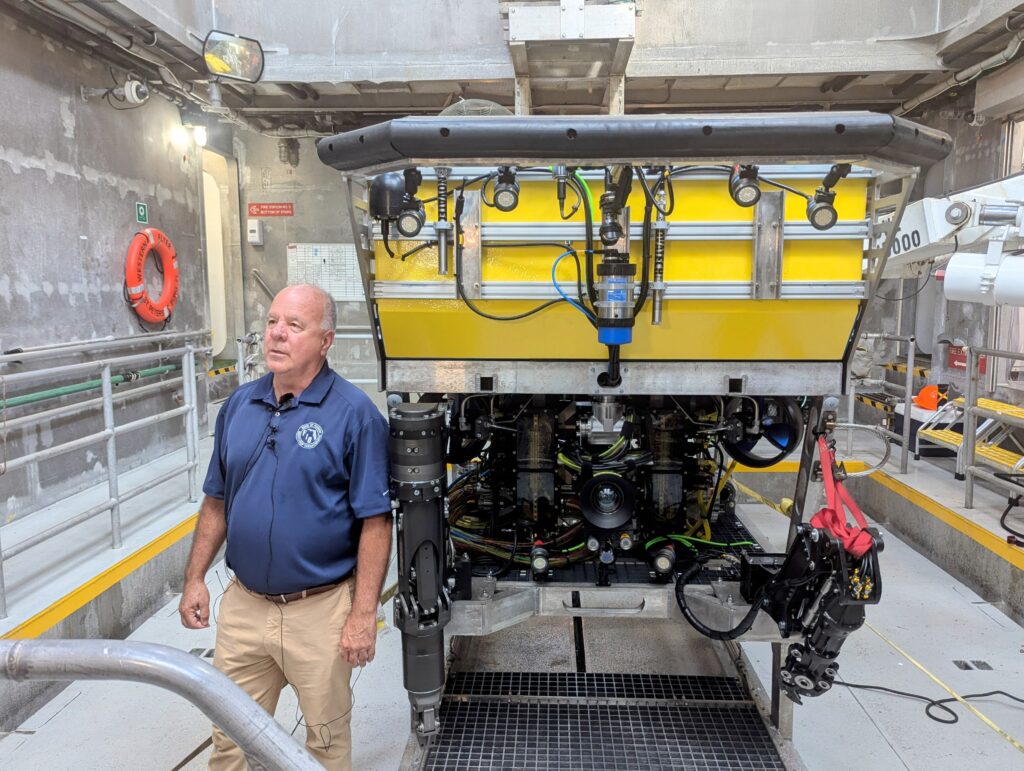A new partnership between the Florida Institute of Oceanography, University of South Florida and Largo-based EaseAlert will increase safety and accessibility aboard a unique local research vessel.
The R/V Western Flyer, stationed on Bayboro Harbor in St. Petersburg, now utilizes EaseAlert’s tactile and visual alert system. The startup’s wearable technology notifies crew members of onboard emergencies by vibrating and flashing red LED lights.
The innovative system reduces the startle response caused by traditional audible alarms. It also ensures crew members receive alerts they might otherwise miss due to engine room noise.
“No matter where you are, what you are doing or what you have around your ears or your eyes, you will feel that alert,” said Blake Richardson, CEO and co-founder. “When it’s an emergency notification – nobody can afford to miss that or even be delayed by 60, or even less, seconds. It’s really critical.”
The system includes bunk alerts, which also feature red LED lighting. Richardson explained that those enable sleeping crew members to respond without being jolted out of bed by bright fluorescent strobes or ear-splitting sirens.
EaseAlert has primarily partnered with fire departments. Richardson said firefighters are 14 times more likely to have a heart attack – the leading cause of work-related deaths – from a jarring alarm than they are in the line of duty.
Dr. Monty Graham, director of the Florida Institute of Oceanography (FIO), has long stressed the importance of increasing inclusivity in marine science. The EaseAlert system will aid those efforts.

Dr. Monty Graham, director of the Florida Institute of Oceanography, stands next to the Western Flyer’s state-of-the-art submersible. Photo by Mark Parker.
USF St. Petersburg hosts the FIO. Chris Sharp, communications manager, noted that the university’s Student Accessibility Services department “has been in lockstep with us during the acquisition of this.”
EaseAlert’s multi-sensory solution allows students and researchers to overcome physical limitations. The technology ensures that those who are deaf, hearing or visually impaired can still safely participate in deep-sea exploration.
“It’s not just folks who have visual and hearing disabilities,” Sharp added. “Some of these students or researchers have issues with anxiety. This (EaseAlert) is, obviously, a lot less of a trigger for any anxiety issues they might have than a blaring alarm system.”
Richardson’s father is a firefighter, and EaseAlert launched in 2019 to mitigate the stress associated with startle alarm responses. He said the startup participated in a National Institute of Health study that found the system improved health outcomes by 388% compared to audible alerts.
EaseAlert is an Embarc Collective member and has since contracted with the Department of Defense. Richardson said potential uses include active shooter and any other situation that requires silent, immediate and effective alerts.
“For us, it’s just a matter of going wherever that need is most pressing and impactful,” he said.
Richardson and his co-founder met Graham at the Maritime and Defense Technology Hub networking event. The Western Flyer often docks at the facility, adjacent to the College of Marine Science at USF St. Petersburg.
Richardson said Graham immediately recognized EaseAlert’s potential. The renowned marine scientist contacted the co-founders before a deaf researcher joined the crew on an expedition.
“That was the reintroduction to make this opportunity official,” Richardson added. “It’s an incredible introduction to the world of maritime research – and the maritime world in general. For us, it’s incredibly important to start with the right first step and right first impression with the right organization.”
He believes the FIO is that organization, and having his startup’s tech aboard the Western Flyer will foster opportunities with the U.S. Navy and Coast Guard. While he could not disclose terms of the deal, Richardson said the FIO received a “significant discount for being the first in this space and being an early-adopted partner of our technology.”
The FIO also operates the R/V Weatherbird II, R/V Hogarth and the Keys Marine Laboratory. Sharp said the organization could potentially purchase additional systems for its other ships.
Richardson appreciates the local startup ecosystem’s collaborative nature. He noted that stakeholders celebrate each other’s wins and believes Tampa Bay’s technological output can compete nationally.
“I wouldn’t want to be anywhere else,” Richardson said. “There’s a great presence and footprint here of big industrial, organizational entities making changes and using new technologies. So, it’s a really great synergy.”
The post Deep-sea research vessel utilizes local startup’s tech first appeared on St Pete Catalyst.
The post Deep-sea research vessel utilizes local startup’s tech appeared first on St Pete Catalyst.
